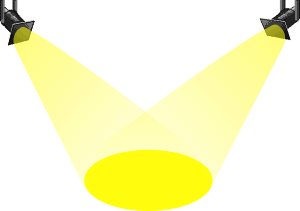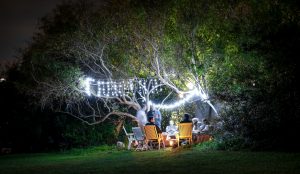When it comes to designing or renovating a space in your property, lighting is usually one of the final elements to be decided. But this doesn’t mean that the impact of lighting can be overlooked.
Nowadays, consumers are typically choosing between spotlights, floodlights, and downlights. But what’s the difference?
The clue is in their names. Spotlights, floodlights, and downlights each have different beam widths. While spotlights give off a narrow beam, floodlights do the opposite by illuminating large areas. Downlights, whereas, sit somewhere in the middle, as they can have a variety of beam widths, but the light is fixed in a downward direction.
The choice you make can drastically alter the ambiance of a space and determine how you use an area. So it’s essential to get it right!
If you’re confused about whether you need spotlights, downlights, or floodlights for your latest project, then this article is for you.
I’ll be exploring what they are, how they’re used, and where you should feature them in your home.
What Are Floodlights, Spotlights And Downlights?
Once you’ve settled on using LEDs, the next step is to choose what form you want your lights to take. Let’s delve deeper.
Spotlights Explained
Spotlights are a concentrated light source. They produce narrow cones of light that can be adjusted and pointed in different directions.
The beam emitted by spotlights is approximately 45 degrees wide, which makes it easy to control. For this reason, spotlights are a popular choice for stage lighting as they can accurately highlight the person or object that is the center of attention.
Spotlights feature a mounting plate or fixing bracket that is attached directly to a wall or ceiling. These brackets are accompanied by single, double, triple, or quadruple moveable spotlights.
The most common LED spotlight bulbs are GU10s and MR16s. While GU10s operate at 240 volts, MR16s operate at 12 volts. 240 volts is the same voltage as the mains electricity supply, so GU10s can be plugged straight into existing or new fittings. MR16s, whereas, require an external transformer to decrease the mains voltage.
Floodlights Explained
Floodlights are the polar opposite of spotlights. As the name suggests, they produce a very wide beam of light. This means they’re ideal for illuminating larger areas.
The beam spread of a floodlight is around 120 degrees, making them a solid lighting option. For this reason, they’re usually found in external locations. In fact, English football clubs have been using floodlights to illuminate pitches since October 1878 (The Away Section).
What’s more, floodlights light up extensive areas using the same wattage and while maintaining the same lumen output as spotlights. LED floodlights are therefore extremely efficient.
An LED floodlight is made of four components: housing, a reflector, a yoke, and the diode. The housing surrounds the diode and prevents light from spilling frivolously in all directions. The housing is lined with a reflector that helps to maximize light output. Finally, a yoke is used to support, suspend, and rotate the floodlight.
Downlights Explained
Unlike spotlights that protrude from the surface, they’re attached too; downlights are a covert luminaire. They are generally embedded inside architecture so that only their front face is visible. Downlights are therefore praised for helping to preserve the streamlined appearance of modern homes.
As a whole, downlights are very diverse. They can either be recessed or flush to the surface, fixed or rotating, and have a narrow, medium, or wide beamwidth.
LED downlights can be categorized into the following groups:
- Fixed – light is emitted in a downwards direction and cannot be adjusted.
- Tilt – the centre of the fixture can be adjusted by around 20 degrees to move the direction of the beam.
- Eyeball – similar to tilt downlights but the centre sticks out to allow more flexibility.
- Wall Washers – feature a hinged housing that can be adjusted to spread light on walls or pictures.
Most downlights consist of a steel or aluminium casing that is hidden from view, and a decorative fascia. During installation, a hole is cut into the wall or ceiling and the downlights are held into place using springs or compression clips.
What Are The Differences?
In essence, the main difference between spotlights, floodlight, and downlight is their beam angle. Beam angle is the measurement of angles that are formed between the centre cone of light and the points on either side of the centre where the light’s intensity is 50 percent as bright.
| Type of Light | Beam Angle |
|---|---|
| Spotlight | 45° |
| Floodlight | 120° |
| Downlight | Varies from fixture to fixture |
Where Is The Best Application?
Since spotlights, floodlights, and downlights have different beam angles, it follows that each light is best suited to a different application.
Spotlights cast a localized beam, which means they’re great for accentuating specific areas or workplaces around the home or garden. Thanks to their narrowness, they are frequently found in museums, above garage doors, and in restaurants.
In the home, most people use spotlights to illuminate specific points of interest, such as artwork or interesting architecture. They’re easy to control, which allows the light to be concentrated on these focal points while keeping everything else concealed.
Floodlights, on the other hand, tend to be used to illuminate larger areas such as car parks, warehouses, driveways, and sports pitches. Their broad-beamed nature means that floodlights are considered too harsh for indoor use, as they would make the space feel very artificial and harsh.
In terms of downlights, they are routinely used to create zones, navigate around space, and highlight critical areas. As they are installed into the surface, downlights are often found inside cabinets, and above workspaces or tables.
There are lots of variations of downlight, which means they’re incredibly versatile. However, it’s important to consider clearing space to make enough room between the ceiling and the floor above for the downlight to be installed.
Which Is Better For the Kitchen?
Good lighting set up will use several types of light to create interest and add dimension to a room. In kitchens, light needs to feel ambient and homely while being bright enough that you can still see what you’re cooking.
Nowadays, most kitchens use tilt or eyeballs downlights as the primary source of light. They are very similar to spotlights, as they can be adjusted to ensure that all areas of the room are lit. However, they are favored due to their aesthetic appeal.
On top of this, spotlights are used over counters, islands, or tables. These are the areas that people are going to be preparing, cooking, and eating food, so they must be well-lit.
Floodlight or Spotlight: What Should You Use For Landscape?
When it comes to choosing landscape lighting, the key is to focus on the purpose of your lighting.
If you want to illuminate the entirety of your home and garden, floodlights are the answer. Their wide range means they’re ideal for large areas. Research also shows that illuminating the exterior of your house is a strong crime deterrent.
The downside of floodlights, nevertheless, is that you have no control over the light path. This means floodlights may be inappropriate if you have a small yard or close-by neighbors.
Alternatively, if you’re looking to highlight a particular feature such as a doorway, footpath, or statue, spotlights are what you need. Unlike floodlights, spotlights are very concentrated, which means you can direct the beam precisely where you want it to be without causing a disturbance or unnecessary light pollution.
Final Words
It’s fair to say that between spotlights, floodlights, and downlights, all of your lighting needs are covered.
The narrow beam of spotlights means they’re perfect for illuminating focal points. In contrast, floodlights are better for spreading light evenly over a large area. Downlights are similar to spotlights; however, they’re embedded into the surface.
Each type of light has different applications, so they’re all equally valuable for your home or property.
If you have spotlights, floodlights, or downlights in your home, which is your favorite?
I’m interested to know whether one type of light is favored over the others, so please let me know by writing a comment below.
Looking for an LED bulb but not sure what type you need?
Check out my free bulb picker and select the right bulb within few clicks.



